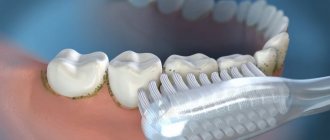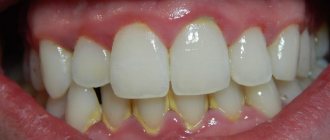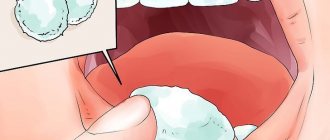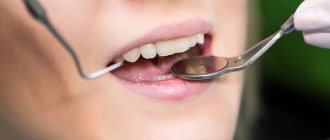Why does tartar appear?
The cause of tartar formation in children and adults, in most cases, is poor hygiene or an unhealthy environment in the oral cavity. After eating, crushed food debris mixes with saliva and bacteria to form plaque on the surface of the teeth. It can be easily removed with toothbrushes or floss if done in a timely manner. If teeth cleaning is not carried out regularly, and the composition of our saliva is disturbed, then over time the usual yellow plaque hardens, turning into mineralized deposits, which can only be removed with the help of special devices for removing tartar.
Depending on the location in relation to the gum, supragingival and subgingival tartar are distinguished. Supragingival is easy to detect on your own during examination. It is a yellow or brown clay-like consistency that can be removed with a special tool. The main places for the formation of such a stone are in the area of active salivation. Subgingival calculus has a hard base that is dark brown or greenish-black in color. It can only be detected by gum recession or with the help of a probe. The formation of subgingival deposits is possible on any tooth, regardless of the distance of the salivary glands.
Ultrasound removal of stones
This is the most effective and safe method currently used to remove hardened formations. Of course, the human factor must also be taken into account: the tip must be in experienced hands, and then there will be tangible benefits from the procedure.
Scaler is an ultrasonic device for destroying stone. In the inner part of the device body there is a motor, due to which the tip vibrates (the mechanism provides more than 100 million movements per minute). When the tip of the nozzle comes into contact with deposits, it creates a vibration that can destroy the stone.
During the entire procedure, a liquid (antiseptic solution or water) is used to cool the tip of the device and the surface of the teeth, washing away deposits located in the dental pockets. A saliva ejector is placed in the oral cavity, effectively removing excess fluid.
But the procedure does not end with the elimination of large deposits, because there are still roughnesses on the surface of the teeth that need to be gotten rid of. If you ignore this, then a soft coating may adhere to the unevenness, which will quickly begin to harden, that is, the process of stone formation will begin all over again. This stage is called polishing, and the procedure itself is carried out using a brush and paste.
Sometimes (especially with gum inflammation) anti-inflammatory therapy and the use of a special paste for several weeks that reduces the inflammatory process are required.
Why is tartar dangerous?
The formation of dental plaque, and then tartar, is possible for various reasons: the involvement of only one side of the jaw, left or right, in chewing; dietary habits, in particular, eating only soft foods; salt imbalance in the body; using low-quality toothbrushes; crooked teeth; smoking. And some people have a congenital predisposition to the appearance of stones. In such cases, even regular care does not guarantee the safety of teeth.
Microbes, which make up 95% of plaque, form acid during their life processes, which, due to tartar, cannot be neutralized by the alkaline environment of the oral cavity. As a result, the enamel is gradually destroyed, and a favorable environment for the formation of caries is formed. Tartar also negatively affects the gums - located between the gum and the tooth, it becomes overgrown with new plaque, which in turn penetrates the gums and causes inflammation. This creates an unpleasant odor in the mouth, gingivitis develops, and with further neglect, periodontitis.
How does the procedure work?
No special preparation is required for ultrasonic teeth cleaning. The patient comes to the clinic at the appointed time.
Procedure steps:
- Examination of the patient's oral cavity and rinsing it with a disinfectant solution. No anesthesia is required.
- Installation of suction to remove stone particles and wash water.
- The doctor uses an ultrasonic scrubber to clean the teeth from deposits.
Next, the molars, incisors and canines are treated with polishing pastes. At the end of the procedure, the dentist will give recommendations for oral care. As a rule, this is rinsing with antiseptics and healing drugs for 3-5 days.
Methods for removing tartar
How to remove tartar? Naturally, this should be done exclusively in a dental office. Previously, tartar cleaning was done mechanically, using special hooks. Subsequently, they decided to abandon this method. Firstly, it was not painless, and secondly, it was not effective, and damage to the tooth and gums could occur. This caused a lot of problems in the treatment and prevention of periodontitis in children and adults. Currently, there are two ways to remove tartar: laser and ultrasonic tartar removal.
Ultrasound
Ultrasound removal of tartar is a new technology in the fight against fossils on teeth, which effectively gives a 100% result in cleaning teeth and gums. However, it must be used with extreme caution in case of cardiovascular diseases and is strictly prohibited if you have a pacemaker. How to get rid of tartar using ultrasound? It's quite simple. An ultrasonic scaler causes vibrations and vibrations of a certain frequency, with the help of which the tooth surface is carefully cleaned of fossils without damaging the tooth. Thanks to the cavitation effect (strong turbulence of the liquid), contact of the device nozzle with the tooth is prevented.
Moreover, when removing tartar with ultrasound, oxygen is released from the water, which disinfects the treated area. In addition, mechanical cleansing of the root and gum occurs. The entire process is absolutely bloodless and painless; only in cases of high sensitivity, tartar removal is carried out using an anesthetic gel.
Laser
Lasers are also used against tartar, but this method is not as popular as ultrasound. The principle of operation of the laser is similar to the removal of tartar using ultrasound and is aimed at crushing fossilized deposits into small parts. However, a laser machine is several times more expensive than ultrasound equipment, so not many clinics will be ready to offer it to you.
Air Flow abrasive treatment
The principle of the Air Flow method is to apply a solution under pressure, which contains water and abrasives, to the teeth. The mixture is applied to the teeth under pressure and, as a result of air-abrasive treatment, the surface of the teeth is cleaned of yellow plaque and surface pigmentation. The method is used as an auxiliary procedure after removing tartar with ultrasound. Air abrasive treatment removes its residues in hard-to-reach areas, the enamel is ground and polished. The Air Flow technique can also be effective as an independent procedure, but only in the fight against stone formations in the initial stages.
Chemical etching
Etching is used as an auxiliary technique in the same way as air abrasive processing. Chemical exposure is carried out using acids or alkalis, which allows you to dissolve or soften tartar, facilitating its further removal. Today this technique is practically not used.
Does it hurt to clean stones on your teeth?
The specific sensations of a particular patient depend on the method of cleaning the stone on the teeth and the individual sensitivity of the person. Everyone's pain threshold is different, so you shouldn't rely on other people's reviews. What may seem intolerable to someone else will remind you of a mosquito bite and vice versa.
Important. When choosing a method for removing stones from teeth, listen to your doctor’s recommendations. The dentist makes a decision based on the results of the examination - the condition of the enamel, the amount of deposits, predisposition or the presence of diseases such as periodontal disease and periodontitis.
Ultrasonic cleaning
Hard dental deposits can only be removed using an ultrasonic scaler. Under the influence of ultrasonic waves, the stones completely crumble, while the enamel remains intact. The procedure is practically painless, but with increased sensitivity, discomfort may occur. In this case, the doctor uses special anesthesia.
A slight pain may also occur when treating gum pockets. But the feeling is quite tolerable and lasts literally a fraction of a second. Ultrasonic cleaning is the only possible way to remove hard stones from pockets, and you should not refuse to do it. It is better to warn your doctor before the procedure that you have increased tooth sensitivity.
When treating areas with enamel, that is, the teeth themselves, pain, as a rule, does not occur.
The main advantages of the method include:
- ideal cleaning quality - the enamel becomes smooth and even;
- the ability to remove hard deposits from interdental spaces and hard-to-reach places;
- bactericidal effect - pathogenic microflora dies under the influence of ultrasonic waves, which reduces the risk of caries;
- optical effect - after removing brown spots and stripes, the enamel becomes visually lighter.
The procedure for removing tartar is mandatory before prosthetics, implantation, before installing braces, and other orthopedic manipulations. Hygienic cleaning with a scaler is also indicated in cases of periodontal disease and periodontitis, twice a year. In other cases, it is recommended to remove tartar with ultrasound once every 12 months.
The duration of the procedure depends on the condition of the patient’s teeth, but, as a rule, does not exceed 40-60 minutes. In especially severe cases, the doctor performs cleaning over several visits.
There are contraindications:
- severe heart disease, the presence of a pacemaker - the ultrasonic wave can disrupt the rhythm of the heart or the device;
- pregnancy - ultrasonic cleaning can negatively affect the development of the fetus, and also lead to miscarriage or premature birth;
- increased pathological sensitivity of the enamel - here we are talking not so much about the pain syndrome, but about the reaction of the body as a whole;
- rehabilitation period after operations and infectious diseases.
Another risk factor is childhood. You can remove stones from your teeth no earlier than two years after the last tooth erupts.
Important. It is not possible to remove hard plaque from teeth at home. In fact, the stone grows into the pores of the enamel, and even the hardest toothbrush is not able to remove it.
Laser removal
From a pain point of view, the procedure is considered completely painless. The laser beam completely destroys hard and soft deposits without affecting the enamel. Dentists recommend removing tartar with a laser in cases where cleaning of the gum pockets is not required. Perhaps this is the only drawback of the procedure.
After laser cleaning, the enamel becomes smoother, its resistance to external influences increases, and the likelihood of caries, gingivitis, and stomatitis decreases. The procedure takes no more than an hour. The main indication for laser stone removal is the presence of hard plaque on the teeth.
There are a number of contraindications - pregnancy, postoperative period, decreased immunity, infectious diseases. These also include untreated caries, a large number of fillings, and increased sensitivity of tooth enamel.
Laser stone removal is an expensive procedure.
Air-Flow
The procedure involves cleaning teeth from stone using a water-dispersed mixture under pressure. Small crystals remove soft plaque from the enamel, while simultaneously polishing it. The main advantage of the technique is a high degree of teeth cleansing even in the most difficult to reach places, including gum pockets.
Air-Flow is traditionally used in combination as a subsequent step after ultrasonic cleaning. As a result, teeth are completely cleaned of hard and soft deposits. The teeth become smooth, as if polished.
The special advantages of the method include:
- painlessness - the patient does not experience discomfort even with very sensitive enamel;
- excellent result - interdental spaces, gum pockets are perfectly cleaned, pigmentation is eliminated;
- natural whitening – by removing stains, teeth become one or two shades lighter;
- hypoallergenic - the mixture contains water, fine-crystalline soda, citrus fragrance.
The effect is especially noticeable for those who have orthopedic structures installed in their mouths - crowns, braces, veneers, implants. The procedure is also recommended for regular use by smokers and lovers of strong tea and coffee.
Removing stones from teeth using this method is contraindicated:
- patients with respiratory diseases - to avoid a possible attack;
- with thin enamel and pathological sensitivity of teeth;
- with caution during pregnancy.
The procedure is carried out in 30-40 minutes, while the patient experiences a feeling of comfort, which is facilitated by a light massage of the gums.
Complete cleaning of teeth and interdental pockets reduces the risk of caries to a minimum.
Chemical removal
It is also possible to clean off old tartar chemically - this method is now used extremely rarely, only in cases where ultrasound and air flow are powerless. A composition containing chemically active substances is applied to the enamel. Under their influence, the stone softens and is cleaned manually.
The method is painless, but is not recommended for thin enamel, increased tooth sensitivity and the presence of open carious cavities.
The second name of the procedure is chemical bleaching. The enamel becomes lighter by 3-4 tones.
Mechanical cleaning
The procedure is extremely unpleasant and is now practically not used anywhere. Hard tartar and soft plaque are removed with special metal spatulas. During the manipulation, there is a high risk that the doctor’s hand may slip and the instrument may damage the gums. The effectiveness of the method is in question, since it is not possible to completely remove deposits.
Prevention of tartar
Tartar appears after the formation of yellow plaque on the teeth, so various ways to combat it will be prevention. The main thing here is safety! Toothpaste can be used as an affordable preventative against tartar. Fluoride-containing and whitening toothpastes are suitable. The former have relatively safe abrasiveness, due to which it is possible to effectively remove plaque. But due to the possibility of damage to the enamel, this product cannot be used constantly. As an alternative, you can buy an ultrasonic brush, which removes plaque quite effectively, which means it is a good prevention of tartar. Fluoride-containing toothpastes, in turn, are biologically active and can increase the resistance of teeth to caries, which is very important if they are prone to the formation of tartar. Using ultrasonic brushes and the best irrigators can also help combat simple deposits. The correct mouth rinse, which contains potassium citrate, will also prevent the formation of tartar.
Traditional medicine offers alternative methods of prevention in the fight against tartar. Raw hard fruits and vegetables such as black radishes, apples, carrots and radishes remove plaque naturally. A decrease in the formation of tartar has also been noted in people who consume lemon, birch sap and peas. Measures to remove tartar at home, such as the use of sand, soda and salt, are ineffective. They are strictly not recommended, as they can cause irreparable damage to tooth enamel. In general, removing tartar using folk remedies should be treated with great caution.
The use of pastes, special brushes and folk remedies to prevent the appearance of tartar will, of course, be beneficial. But only a dental hygienist can remove large and complex formations. Experts strongly recommend that absolutely everyone undergo professional hygienic cleaning twice a year. This is partly due to the fact that on average it takes about six months to form tartar. Regular visits to the hygienist’s office are the most reliable way to prevent not only dental plaque, but also diseases such as caries, gingivitis and periodontitis. Don't forget that dental treatment is much more expensive than the cost of professional oral hygiene from a hygienist.
Dental care
The presence of tartar leads to diseases of the gums and teeth. These are periodontitis and periodontal disease, gingivitis and caries. Special equipment is required to remove stones. This issue can best be resolved by a dentist in a hospital or dental office. During professional cleaning, the doctor will be able to treat the most difficult to reach areas. The procedure of polishing your teeth will make them smooth, which will reduce the likelihood of new plaque sticking to the enamel. If there is intense formation of soft plaque, you should immediately carry out professional cleaning and remove stones.
How much does tartar removal cost?
The price of the procedure for removing tartar with ultrasound or laser is usually included in the cost of the complex, called professional hygiene. Some clinics set a total price for hygienic cleaning of the entire oral cavity, and some set a general price for the treatment of one tooth. So, in Moscow, the price for cleaning one tooth, including removing tartar from it, ranges from 50 to 500 rubles, that is, the cost of the entire procedure, depending on the number of teeth and the category of the clinic, will vary from 1,400 to 16,000 rubles and more .
Should I remove tartar? For people who care about the health of their teeth, the answer to this question will be clear. Tartar should be removed in the same way as brushing your teeth and removing thick plaque on the tongue. And, of course, we must not forget about professional oral hygiene. Remember that by coming to a specialist on time, you are laying a healthy foundation for your health without leaving a single stone on your teeth.
Tartar: how to get rid of it at home
Most people understand that the best way to resolve any dental problems is to visit the dentist. However, not everyone likes to contact a specialist, delaying the visit until the last minute in the hope that the problem will somehow resolve itself. This is largely facilitated by advertising offering treatment for all occasions.
So how to remove tartar at home? Unfortunately, no way. Even the most expensive products will not be able to remove thick plaque and stone. However, ultrasonic or electric brushes, as well as special toothpastes, will help get rid of the soft plaque that is just beginning to form.











